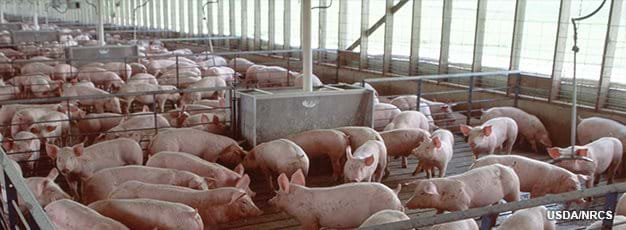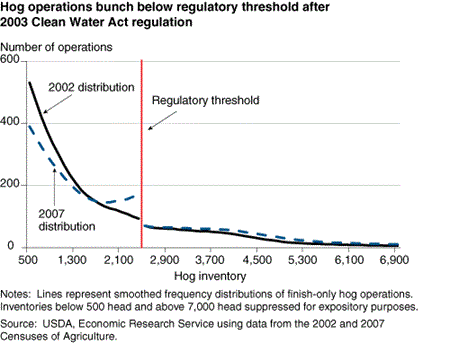Stricter Rules Prompt Livestock Producers To Choose Farm Size Just Below Regulatory Cutoff

In 2003, the U.S. Environmental Protection Agency strengthened Federal Clean Water Act (CWA) regulations governing the handling and application of manure by livestock operations. An important and unchanging feature of these CWA regulations is that operations confining more than a specific number of livestock face more stringent rules. In recent decades, livestock production has increasingly shifted to larger operation sizes that have lower production costs per head. As a result of this structural shift, over time, more operations will face the more stringent regulations. However, farmers could avoid CWA regulations by adjusting the size of their operations to just below the cutoff.
'Bunching' in the size distribution of livestock operations--that is, an unexpectedly large number of farms located just below the regulatory threshold--suggests that some operators may be keeping the size of their herds at a certain level to avoid the costs of regulation. In the process, they may reduce the regulation's effectiveness and forego economies of scale that increase the efficiency of their operations. Bunching implies that some livestock operators give up lower production costs per head at larger sizes rather than deal with the added costs of regulation.
ERS researchers used U.S. Census of Agriculture data from 2002 and 2007 to examine the size distribution of livestock operations before and after the adoption of the stricter 2003 regulations. The research focused on 'finish-only' hog farms--operations where pigs are raised until they reach market weight. The CWA size threshold was constant at 2,500 head over this period, which made it easier to examine how farm size changed in response to the new rules.
Evident from the findings is the general shift to larger sizes between 2002 and 2007, with fewer operations with less than 1,700 head and more operations with greater than 3,500 head. The distribution varies smoothly across the regulatory threshold prior to adoption of the 2003 CWA rules but shows a sharp discontinuity at the 2,500-head threshold by 2007. Four years after the announcement of the new rules, an estimated 8 percent of potentially regulated operations near the threshold 'avoided' regulation by remaining just below the cutoff. Results vary sharply by region, with up to 23 percent of operations avoiding regulations in some States.
'Effects of Clean Water Act Regulations on Operation Size: Evidence of Regulatory Avoidance', American Journal of Agricultural Economics, July 2011, 93(4), pp. 1189-1211


